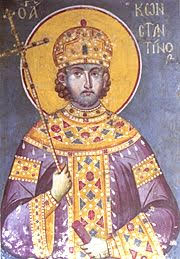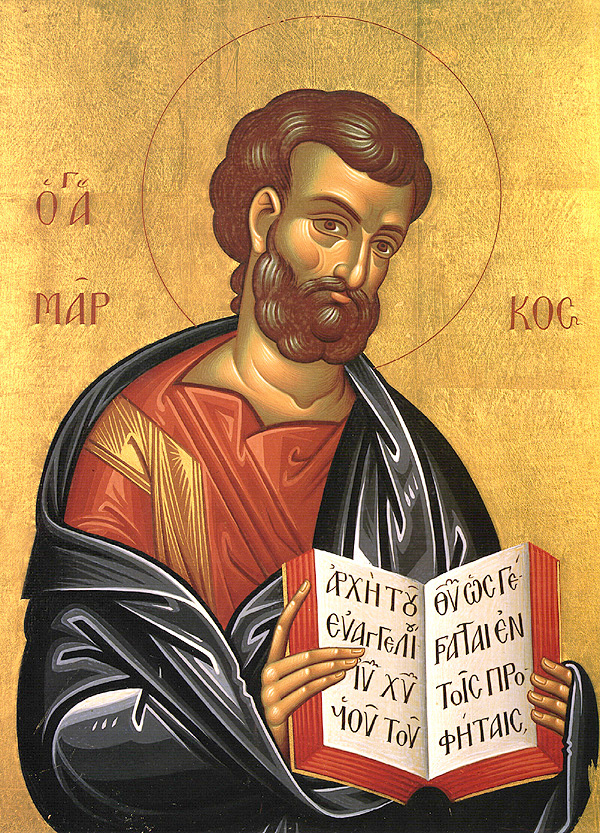The young Athanasius, whom the children designated as “bishop”, performed the Baptism, precisely repeating the words he heard in church during this sacrament. Patriarch Alexander observed all this from a window. He then commanded that the children and their parents be brought to him. He conversed with them for a long while, and determined that the Baptism performed by the children was done according to the Church order. He acknowledged the Baptism as real and sealed it with the sacrament of Chrismation. From this moment, the Patriarch looked after the spiritual upbringing of Athanasius and in time brought him into the clergy, at first as a reader, and then he ordained him as a deacon.
Culture
Sunday of Holy Pentecost
26. May 2018 - 23:38![]() Introduction
Introduction
The Feast of Holy Pentecost is celebrated each year on the fiftieth day after the Great and Holy Feast of Pascha (Easter) and ten days after the Feast of the Ascension of Christ. The Feast is always celebrated on a Sunday.
The Feast commemorates the descent of the Holy Spirit upon the Apostles on the day of Pentecost, a feast of the Jewish tradition. It also celebrates the establishment of the Church through the preaching of the Apostles and the baptism of the thousands who on that day believed in the Gospel message of salvation through Jesus Christ. The Feast is also seen as the culmination of the revelation of the Holy Trinity.
Commemoration of the Precious Cross that appeared in the sky over Jerusalem in 351 A.D.
20. May 2018 - 14:33 Reading
Reading
On this day in the year 351, not long after Cyril had succeeded Maximus as Archbishop of Jerusalem, during the reign of Constantius, the son of Saint Constantine the Great, on the day of Pentecost, the sign of the Cross appeared over Jerusalem. Saint Cyril, in his letter to the Emperor Constantius, says, "At about the third hour of the day, an enormous Cross, formed of light, appeared in the heaven above holy Golgotha and reaching to the holy Mount of Olives, being seen not by one or two only, but manifest with perfect clarity to the whole multitude of the city; not, as one might suppose, rushing swiftly past in fancy, but seen openly above the earth many hours in plain sight, and overcoming the beams of the sun with its dazzling rays" (PG 33:1 16q).
Weekly Diocesan Bulletin - Sunday, May 20, 2018
19. May 2018 - 13:28
SEVENTH SUNDAY OF PASCHA: THE HOLY FATHERS OF THE FIRST ECUMENICAL COUNCIL; APPEARANCE OF THE PRECIOUS CROSS OVER JERUSALEM IN 351
RESURRECTIONAL TROPARION - TONE SIX:
The angelic powers were at Thy tomb; the guards became as dead men. Mary stood by Thy grave, seeking Thy most pure Body. Thou didst capture hell, not being tempted by it. Thou didst come to the Virgin, granting life. O Lord who didst rise from the dead: Glory to Thee!
St. Athanasius the Great the Patriarch of Alexandria
14. May 2018 - 21:43 Saint Athanasius the Great, Archbishop of Alexandria, was a great Father of the Church and a pillar of Orthodoxy. He was born around the year 297 in the city of Alexandria into a family of pious Christians. He received a fine secular education, but he acquired more knowledge by diligent study of the Holy Scripture. In his childhood, the future hierarch Athanasius became known to Saint Alexander the Patriarch of Alexandria (May 29). A group of children, which included Athanasius, were playing at the seashore. The Christian children decided to baptize their pagan playmates.
Saint Athanasius the Great, Archbishop of Alexandria, was a great Father of the Church and a pillar of Orthodoxy. He was born around the year 297 in the city of Alexandria into a family of pious Christians. He received a fine secular education, but he acquired more knowledge by diligent study of the Holy Scripture. In his childhood, the future hierarch Athanasius became known to Saint Alexander the Patriarch of Alexandria (May 29). A group of children, which included Athanasius, were playing at the seashore. The Christian children decided to baptize their pagan playmates.
Saint Basil the Bishop of Ostrog
11. May 2018 - 11:12 Saint Basil, Bishop of Zakholmsk, was born of pious parents in the sixteenth century in the Popov district of Herzegovina. At the age of maturity he left his parental home and settled in the Trebinsk monastery in honor of the Dormition of the Most Holy Theotokos, and became a monk.
Saint Basil, Bishop of Zakholmsk, was born of pious parents in the sixteenth century in the Popov district of Herzegovina. At the age of maturity he left his parental home and settled in the Trebinsk monastery in honor of the Dormition of the Most Holy Theotokos, and became a monk.
For his virtuous life the saint was elevated to be Bishop of Zakholm and Skenderia. He occupied the bishop’s cathedra in the second half of the sixteenth century, a successor to Bishop Paul and predecessor of Bishop Nicodemus. Saint Basil was a good pastor of the flock of Christ, and the Lord strengthened his discourse with various miracles. For the sanctifying of soul with the wisdom of holy ascetic fathers, the saint journeyed to Athos. Saint Basil died peacefully and was buried in the city of Ostrog in Montenegro on the border with Herzegovina.
Apostle Mark the Evangelist of the Seventy
7. May 2018 - 21:59 The Holy Apostle and Evangelist Mark, also known as John Mark (Acts 12:12), was one of the Seventy Apostles, and was also a nephew of Saint Barnabas (June 11). He was born at Jerusalem. The house of his mother Mary adjoined the Garden of Gethsemane. As Church Tradition relates, on the night that Christ was betrayed he followed after Him, wrapped only in a linen cloth. He was seized by soldiers, and fled away naked, leaving the cloth behind (Mark 14:51-52). After the Ascension of the Lord, the house of his mother Mary became a place where Christians gathered, and a place of lodging for some of the Apostles (Acts 12:12).
The Holy Apostle and Evangelist Mark, also known as John Mark (Acts 12:12), was one of the Seventy Apostles, and was also a nephew of Saint Barnabas (June 11). He was born at Jerusalem. The house of his mother Mary adjoined the Garden of Gethsemane. As Church Tradition relates, on the night that Christ was betrayed he followed after Him, wrapped only in a linen cloth. He was seized by soldiers, and fled away naked, leaving the cloth behind (Mark 14:51-52). After the Ascension of the Lord, the house of his mother Mary became a place where Christians gathered, and a place of lodging for some of the Apostles (Acts 12:12).
Saint Mark was a very close companion of the Apostles Peter and Paul (June 29) and Barnabas. Saint Mark was at Seleucia with Paul and Barnabas, and from there he set off to the island of Cyprus, and he traversed the whole of it from east to west. In the city of Paphos, Saint Mark witnessed the blinding of the sorcerer Elymas by Saint Paul (Acts 13:6-12).

